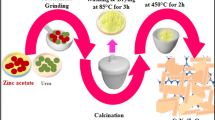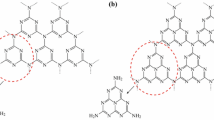Abstract
As an important member of semiconducting transition metal oxides, MoO2 nanomaterials have many advantages in optical and electrical applications. However, MoO2 itself has no significant photocatalytic performance possibly because of its inferior conductivity and strong recombination of photogenerated electron–hole pairs. Here, we propose a facile, one-step pyrolysis method to prepare a novel C fibers@MoO2 nanoparticles core–shell composite, where the oxidative MoO2 nanoparticles in situ grew on the surface of conducting C fibers. Due to the compositing of MoO2 and C fibers, during photocatalysis tests, the recombination of photogenerated electron–hole pairs was effectively inhibited, and the lifetime of the photogenerated carries was efficiently prolonged, finally significantly improving the solar-driven photocatalytic activity on degrading various organic and inorganic pollutants in water, such as methylene blue, rhodamine B, phenol, and potassium dichromate, showing the great potential for environmental remediation by degrading toxic industrial chemicals in waste water under sunlight. Moreover, the composite presented good stability in composition and structure during the repeated use and long-term storage. In addition, this one-step growth method is an easy-to-handle, environmentally friendly, and low-cost synthesis method for large-scale production.








Similar content being viewed by others
References
Y. Liu, L.H. Tian, X.Y. Tan, X. Li, and X.B. Chen: Synthesis, properties, and applications of black titanium dioxide nanomaterials. Sci. Bull. 62, 431 (2017).
Y. Li, D. Lu, L.Q. Zhou, M.L. Ye, X. Xiong, K.Z. Yang, Y.X. Pan, M.H. Chen, P. Wu, T. Li, Y.T. Chen, Z. Wang, and Q.H. Xia: Bi-modified Pd-based/carbon-doped TiO2 hollow spheres catalytic for ethylene glycol electrooxidation in alkaline medium. J. Mater. Res. 31, 3712 (2016).
J.Q. Wen, X. Li, W. Liu, Y.P. Fang, J. Xie, and Y.H. Xu: Photocatalysis fundamentals and surface modification of TiO2 nanomaterials. Chin. J. Catal. 36, 2049 (2015).
Z. Hu, G. Liu, X. Chen, Z. Shen, and J. Yu: Enhancing charge separation in metallic photocatalysts: A case study of the conducting molybdenum dioxide. Adv. Funct. Mater. 26, 4445 (2016).
Z. Feng, L. Zeng, Y.J. Chen, Y.Y. Ma, C.R. Zhao, R.S. Jin, Y. Lu, Y. Wu, and Y.M. He: In situ preparation of Z-scheme MoO3/g-C3N4 composite with high performance in photocatalytic CO2 reduction and RhB degradation. J. Mater. Res. 32, 3660 (2017).
J. Liu, Z. Zhang, C. Pan, Y. Zhao, X. Su, Y. Zhou, and D. Yu: Enhanced field emission properties of MoO2 nanorods with controllable shape and orientation. Mater. Lett. 58, 3812 (2004).
F. Wang and B. Lu: Well-aligned MoO2 nanowires arrays: Synthesis and field emission properties. Physica B 404, 190 (2009).
M.M.Y.A. Alsaif, M.R. Field, B.J. Murdoch, T. Daeneke, K. Latham, A.F. Chrimes, A.S. Zoolfakar, S.P. Russo, J.Z. Ou, and K. Kalantar-zadeh: Substoichiometric two-dimensional molybdenum oxide flakes: A plasmonic gas sensing platform. Nanoscale 6, 12780 (2014).
Y.M. Sun, X.L. Hu, W. Luo, and Y.H. Huang: Self-assembled hierarchical MoO2/graphene nanoarchitectures and their application as a high-performance anode material for lithium-ion batteries. ACS Nano 5, 7100 (2011).
W.H. Edgar, M.B. Jeremy, and R.H. Holm: Thermodynamic fitness of molybdenum (IV,VI) complexes for oxygen-atom transfer reactions, including those with enzymic substrates. J. Am. Chem. Soc. 108, 6992 (1986).
L. Liao, S.N. Wang, J.J. Xiao, X.J. Bian, and Y.H. Zhang: A nanoporous molybdenum carbide nanowire as an electrocatalyst for hydrogen evolution reaction. Energy Environ. Sci. 7, 387 (2013).
D.O. Scanlon, G.W. Watson, D.J. Payne, and G.R. Atkinson: Theoretical and experimental study of the electronic structures of MoO3 and MoO2. J. Phys. Chem. C 114, 4636 (2010).
X. Li, J. Shao, J. Li, L. Zhang, Q. Qu, and H. Zheng: Ordered mesoporous MoO2 as a high-performance anode material for aqueous supercapacitors. J. Power Sources 237, 80 (2013).
Z. Liang, H. Wu, Z. Wang, and X. Lou: Interconnected MoO2 nanocrystals with carbon nanocoating as high-capacity anode materials for lithium-ion batteries. ACS Appl. Mater. Interfaces 3, 4853 (2011).
Y.L. Liu, H. Zhang, P. Ouyang, and Z.C. Li: One-pot hydrothermal synthesized MoO2 with high reversible capacity for anode application in lithium ion battery. Electrochim. Acta 102, 429 (2013).
S. Yoon, K. Jung, C. Jin, and K. Shin: Synthesis of nitrided MoO2 and its application as anode materials for lithium-ion batteries. J. Alloys Compd. 536, 179 (2012).
B.H. Zhang, Y.G. Xue, A.N. Jiang, Z.M. Xue, Z.H. Li, and J.C. Hao: Ionic liquid as reaction medium for synthesis of hierarchically structured one-dimensional MoO2 for efficient hydrogen evolution. ACS Appl. Mater. Interfaces 9, 7217 (2017).
S.Y. Gu, M.L. Qin, H.A. Zhang, J.D. Ma, H.Y. Wu, and X.H. Qu: Facile solution combustion synthesis of MoO2 nanoparticles as efficient photocatalysts. CrystEngComm 19, 6516 (2017).
I.V. Silaev, S.A. Khubezhov, A.G. Ramonova, G.S. Grigorkina, A.G. Kaloeva, Z.S. Demeev, A.P. Bliev, D. Sekiba, S. Ogura, K. Fukutani, and T.T. Magkoev: Photoinduced conversion of carbon dioxide and water molecules to methanol on the surface of molybdenum oxide MoOx ( x < 2). Tech. Phys. Lett. 42, 271 (2016).
N. Dukstiene and D. Sinkeviciute: Photoelectrochemical properties of MoO2 thin films. J. Solid State Electrochem. 17, 1175 (2013).
L.L. Zou, X.Q. Shen, Q.J. Wang, Z. Wang, X.C. Yang, and M.X. Jing: Improvement of catalytic activity and mechanistic analysis of transition metal ion doped nanoCeO2 by aqueous rhodamine B degradation. J. Mater. Res. 30, 2763 (2015).
Q.P. Lu, Y.F. Yu, Q.L. Ma, B. Chen, and H. Zhang: 2D transition-metal-dichalcogenide-nanosheet- based composites for photocatalytic and electrocatalytic hydrogen evolution reactions. Adv. Mater. 28, 1917 (2016).
Q. Peng, Z.Y. Wang, B.S. Sa, B. Wu, and Z.M. Sun: Electronic structures and enhanced optical properties of blue phosphorene/transition metal dichalcogenides van der Waals heterostructures. Sci. Rep. 6, 31994 (2016).
T. Xia, W. Zhang, Z.H. Wang, Y.L. Zhang, X.Y. Song, J. Murowchick, V. Battaglia, G. Liu, and X.B. Chen: Amorphous carbon-coated TiO2 nanocrystals for improved lithium-ion battery and photocatalytic performance. Nano Energy 6, 109 (2014).
S. Zou, Z.H. Fu, C. Xiang, W.F. Wu, S.P. Tang, Y.C. Liu, and D.L. Yin: Mild, one-step hydrothermal synthesis of carbon-coated CdS nanoparticles with improved photocatalytic activity and stability. Chin. J. Catal. 36, 1077 (2015).
X. Liu, Y.H. Zhang, Y.S. Jia, J.Z. Jiang, Y.B. Wang, X.S. Chen, and T. Gui: Visible light-responsive carbon-decorated p-type semiconductor CaFe2O4 nanorod photocatalyst for efficient remediation of organic pollutants. Chin. J. Catal. 38, 1770 (2017).
H.L. Gao, J.M. Liu, J. Zhang, Z.Q. Zhu, G.L. Zhang, and Q.J. Liu: Influence of carbon and yttrium co-doping on the photocatalytic activity of mixed phase TiO2. Chin. J. Catal. 38, 1688 (2017).
J.T. Zhang and F. Huang: Enhanced visible light photocatalytic H2 production activity of g-C3N4 via carbon fiber. Appl. Surf. Sci. 358, 287 (2015).
K. Li, F.Y. Su, and W.D. Zhang: Modification of g-C3N4 nanosheets by carbon quantum dots for highly efficient photocatalytic generation of hydrogen. Appl. Surf. Sci. 375, 110 (2016).
A. Chen, C. Li, R. Tang, L. Yin, and Y. Qi: MoO2-ordered mesoporous carbon hybrids as anode materials with highly improved rate capability and reversible capacity for lithium-ion battery. Phys. Chem. Chem. Phys. 15, 13601 (2013).
X. Liu, W. Ji, J. Liang, L. Peng, and W. Hou: MoO2@carbon hollow microspheres with tunable interiors and improved lithium-ion battery anode properties. Phys. Chem. Chem. Phys. 16, 20570 (2014).
Z.R. Li, Y.L. Fu, M. Jiang, T.D. Hu, T. Liu, and Y.N. Xie: Active carbon supported Mo–K catalysts used for alcohol synthesis. J. Catal. 199, 155 (2001).
X. Pan, S. Li, Z. Wang, L. Yang, K. Zhu, L. Ren, M. Lei, and J. Liu: Core–shell MoO2/C nanospheres embedded in bubble sheet-like carbon film as lithium ion battery anodes. Mater. Lett. 199, 139 (2017).
Y. Wang, L. Yu, and X.W. Lou: Formation of triple-shelled molybdenum-polydopamine hollow spheres and their conversion into MoO2/carbon composite hollow spheres for lithium-ion batteries. Angew. Chem. Int. Ed. 55, 14668 (2016).
J. Jiang, W. Yang, H. Wang, Y. Zhao, J. Guo, J. Zhao, M. Beidaghi, and L. Gao: Electrochemical performances of MoO2/C nanocomposite for sodium ion storage: An insight into rate dependent charge/discharge mechanism. Electrochim. Acta 240, 379 (2017).
B. Liu, X. Zhao, T. Yuan, D. Zhao, C. Hu, and M. Gao: A simple reduction process to synthesize MoO2/C composites with cage-like structure for high-performance lithium-ion batteries. Phys. Chem. Chem. Phys. 15, 8831 (2013).
Z. Chen, T. Yang, H. Shi, T. Wang, M. Zhang, and G. Cao: Single nozzle electrospinning synthesized MoO2@C core shell nanofibers with high capacity and long-term stability for lithium-ion storage. Adv. Mater. Interfaces 4, 1600816 (2017).
W. Cho, J.H. Song, J. Kim, G. Jeong, E.Y. Lee, and Y. Kim: Electrochemical characteristics of nano-sized MoO2/C composite anode materials for lithium-ion batteries. J. Appl. Electrochem. 42, 909 (2012).
H. Huang, K. Liu, K. Chen, Y.L. Zhang, Y.H. Zhang, and S.C. Wang: Ce and F comodification on the crystal structure and enhanced photocatalytic activity of Bi2WO6 photocatalyst under visible light irradiation. J. Phys. Chem. C 118, 14379 (2014).
E. Zhou, C. Wang, Q. Zhao, Z. Li, M. Shao, X. Deng, X. Liu, and X. Xu: Facile synthesis of MoO2 nanoparticles as high performance supercapacitor electrodes and photocatalysts. Ceram. Int. 42, 2198 (2016).
A. Bhaskar, M. Deepa, T.N. Rao, and U.V. Varadaraju: Enhanced nanoscale conduction capability of a MoO2/graphene composite for high performance anodes in lithium ion batteries. J. Power Sources 216, 169 (2012).
E. Zhou, C. Wang, M. Shao, X. Deng, and X. Xu: MoO2 nanoparticles grown on carbon fibers as anode materials for lithium-ion batteries. Ceram. Int. 43, 760 (2017).
S. Qiu, G.X. Lu, J.R. Liu, H.L. Lv, C.X. Hu, B. Li, X.R. Yan, J. Guo, and Z.H. Guo: Enhanced electrochemical performances of MoO2 nanoparticles composited with carbon nanotubes for lithium-ion battery anode. RSC Adv. 5, 87286 (2015).
J.G. Choi and L.T. Thompson: XPS study of as-prepared and reduced molybdenum oxides. Appl. Surf. Sci. 93, 143 (1996).
X.Y. Chen, Z.J. Zhang, X.X. Li, C.W. Shi, and X.L. Li: Selective synthesis of metastable MoO2 nanocrystallites through a solution-phase approach. Chem. Phys. Lett. 418, 105 (2006).
A. Deurbergue and A. Oberlin: Stabilization and carbonization of pan-based carbon fibers as related to mechanical properties. Carbon 29, 621 (1991).
J. Yu, B. Huang, X. Qin, X.Y. Zhang, Z.Y. Wang, and H.X. Liu: Hydrothermal synthesis and characterization of ZnO films with different nanostructures. Appl. Surf. Sci. 257, 5563 (2011).
Z.G. Shen, Z.Y. Zhao, J.W. Qian, Z.J. Peng, and X.L. Fu: Synthesis of WO3−x nanomaterials with controlled morphology and composition for highly efficient photocatalysis. J. Mater. Res. 31, 1065 (2016).
J.W. Qian, Z.Y. Zhao, Z.G. Shen, G.L. Zhang, Z.J. Peng, and X.L. Fu: A large scale of CuS nano-networks: Catalyst-free morphologically controllable growth and their application as efficient photocatalysts. J. Mater. Res. 30, 3746 (2015).
P.M. Mortensen, H.W.P. de Carvalho, J.D. Grunwaldt, P.A. Jensen, and A.D. Jensen: Activity and stability of Mo2C/ZrO2 as catalyst for hydrodeoxygenation of mixtures of phenol and 1-octanol. J. Catal. 328, 208 (2015).
P. Mytych, P. Giela, and Z. Stasicda: Photoredox processes in the Cr(VI)–Cr(III)–oxalate system and their environmental relevance. Appl. Catal., B 59, 161 (2005).
Z. Lu, L. Zeng, W.L. Song, Z.Y. Qin, D.W. Zeng, and C.S. Xie: In situ synthesis of C-TiO2/g-C3N4 heterojunction nanocomposite as highly visible light active photocatalyst originated from effective interfacial charge transfer. Appl. Catal., B 202, 489 (2017).
J.Q. Wen, X. Li, H.Q. Li, S. Ma, K.L. He, Y.H. Xu, Y.P. Fang, W. Liu, and Q.Z. Gao: Enhanced visible-light H2 evolution of g-C3N4 photocatalysts via the synergetic effect of amorphous NiS and cheap metal-free carbon black nanoparticles as co-catalysts. Appl. Surf. Sci. 358, 204 (2015).
J.Q. Wen, J. Xie, Z.H. Yang, R.C. Shen, H.Y. Li, X.Y. Luo, X.B. Chen, and X. Li: Fabricating the robust g-C3N4 nanosheets/carbons/NiS multiple heterojunctions for enhanced photocatalytic H2 generation: An insight into the trifunctional roles of nanocarbons. ACS Sustain. Chem. Eng. 5, 2224 (2017).
ACKNOWLEDGMENTS
Financial support for this work from the National Natural Science Foundation of China (Grant Nos. 11674035 and 61274015) and the Fundamental Research Funds for the Central Universities.
Author information
Authors and Affiliations
Corresponding authors
Supplementary Material
43578_2018_33060685_MOESM1_ESM.pdf
Supplementary Materials: C fibers@MoO2 nanoparticles core-shell composite: highly efficient solar-driven photocatalyst (approximately 736 KB)
Rights and permissions
About this article
Cite this article
Wang, M., Peng, Z., Li, H. et al. C fibers@MoO2 nanoparticles core–shell composite: Highly efficient solar-driven photocatalyst. Journal of Materials Research 33, 685–698 (2018). https://doi.org/10.1557/jmr.2018.32
Received:
Accepted:
Published:
Issue Date:
DOI: https://doi.org/10.1557/jmr.2018.32




